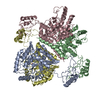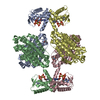[English] 日本語
 Yorodumi
Yorodumi- PDB-7a2g: Full-length structure of the substrate-free tyrosine hydroxylase ... -
+ Open data
Open data
- Basic information
Basic information
| Entry | Database: PDB / ID: 7a2g | |||||||||
|---|---|---|---|---|---|---|---|---|---|---|
| Title | Full-length structure of the substrate-free tyrosine hydroxylase (apo-TH). | |||||||||
 Components Components | Tyrosine 3-monooxygenase | |||||||||
 Keywords Keywords | OXIDOREDUCTASE / Tetramer / catecholamine / brain / Parkinson | |||||||||
| Function / homology |  Function and homology information Function and homology informationtyrosine 3-monooxygenase / tyrosine 3-monooxygenase activity / phytoalexin metabolic process / dopamine biosynthetic process from tyrosine / phthalate metabolic process / glycoside metabolic process / terpene metabolic process / isoquinoline alkaloid metabolic process / norepinephrine biosynthetic process / embryonic camera-type eye morphogenesis ...tyrosine 3-monooxygenase / tyrosine 3-monooxygenase activity / phytoalexin metabolic process / dopamine biosynthetic process from tyrosine / phthalate metabolic process / glycoside metabolic process / terpene metabolic process / isoquinoline alkaloid metabolic process / norepinephrine biosynthetic process / embryonic camera-type eye morphogenesis / hyaloid vascular plexus regression / circadian sleep/wake cycle / epinephrine biosynthetic process / Catecholamine biosynthesis / aminergic neurotransmitter loading into synaptic vesicle / dopamine binding / response to pyrethroid / eye photoreceptor cell development / response to isolation stress / melanosome membrane / sphingolipid metabolic process / response to ether / synaptic transmission, dopaminergic / tetrahydrobiopterin binding / response to herbicide / mating behavior / dopamine biosynthetic process / amino acid binding / regulation of heart contraction / pigmentation / eating behavior / response to corticosterone / response to zinc ion / cellular response to alkaloid / social behavior / response to immobilization stress / smooth endoplasmic reticulum / response to light stimulus / anatomical structure morphogenesis / cellular response to manganese ion / response to electrical stimulus / heart morphogenesis / response to salt stress / response to amphetamine / visual perception / response to nutrient levels / ferric iron binding / fatty acid metabolic process / learning / response to activity / locomotory behavior / cellular response to glucose stimulus / animal organ morphogenesis / ferrous iron binding / terminal bouton / cytoplasmic side of plasma membrane / cerebral cortex development / memory / cellular response to growth factor stimulus / response to peptide hormone / oxygen binding / cellular response to nicotine / cellular response to xenobiotic stimulus / synaptic vesicle / response to estradiol / heart development / cytoplasmic vesicle / perikaryon / response to ethanol / response to lipopolysaccharide / response to hypoxia / neuron projection / protein domain specific binding / axon / dendrite / perinuclear region of cytoplasm / enzyme binding / mitochondrion / identical protein binding / nucleus / cytoplasm / cytosol Similarity search - Function | |||||||||
| Biological species |  Homo sapiens (human) Homo sapiens (human) | |||||||||
| Method | ELECTRON MICROSCOPY / single particle reconstruction / cryo EM / Resolution: 4.1 Å | |||||||||
 Authors Authors | Bueno-Carrasco, M.T. / Cuellar, J. / Santiago, C. / Flydal, M.I. / Martinez, A. / Valpuesta, J.M. | |||||||||
| Funding support |  Norway, Norway,  Spain, 2items Spain, 2items
| |||||||||
 Citation Citation |  Journal: Nat Commun / Year: 2022 Journal: Nat Commun / Year: 2022Title: Structural mechanism for tyrosine hydroxylase inhibition by dopamine and reactivation by Ser40 phosphorylation. Authors: María Teresa Bueno-Carrasco / Jorge Cuéllar / Marte I Flydal / César Santiago / Trond-André Kråkenes / Rune Kleppe / José R López-Blanco / Miguel Marcilla / Knut Teigen / Sara Alvira ...Authors: María Teresa Bueno-Carrasco / Jorge Cuéllar / Marte I Flydal / César Santiago / Trond-André Kråkenes / Rune Kleppe / José R López-Blanco / Miguel Marcilla / Knut Teigen / Sara Alvira / Pablo Chacón / Aurora Martinez / José M Valpuesta /    Abstract: Tyrosine hydroxylase (TH) catalyzes the rate-limiting step in the biosynthesis of dopamine (DA) and other catecholamines, and its dysfunction leads to DA deficiency and parkinsonisms. Inhibition by ...Tyrosine hydroxylase (TH) catalyzes the rate-limiting step in the biosynthesis of dopamine (DA) and other catecholamines, and its dysfunction leads to DA deficiency and parkinsonisms. Inhibition by catecholamines and reactivation by S40 phosphorylation are key regulatory mechanisms of TH activity and conformational stability. We used Cryo-EM to determine the structures of full-length human TH without and with DA, and the structure of S40 phosphorylated TH, complemented with biophysical and biochemical characterizations and molecular dynamics simulations. TH presents a tetrameric structure with dimerized regulatory domains that are separated 15 Å from the catalytic domains. Upon DA binding, a 20-residue α-helix in the flexible N-terminal tail of the regulatory domain is fixed in the active site, blocking it, while S40-phosphorylation forces its egress. The structures reveal the molecular basis of the inhibitory and stabilizing effects of DA and its counteraction by S40-phosphorylation, key regulatory mechanisms for homeostasis of DA and TH. | |||||||||
| History |
|
- Structure visualization
Structure visualization
| Movie |
 Movie viewer Movie viewer |
|---|---|
| Structure viewer | Molecule:  Molmil Molmil Jmol/JSmol Jmol/JSmol |
- Downloads & links
Downloads & links
- Download
Download
| PDBx/mmCIF format |  7a2g.cif.gz 7a2g.cif.gz | 300.4 KB | Display |  PDBx/mmCIF format PDBx/mmCIF format |
|---|---|---|---|---|
| PDB format |  pdb7a2g.ent.gz pdb7a2g.ent.gz | 243.2 KB | Display |  PDB format PDB format |
| PDBx/mmJSON format |  7a2g.json.gz 7a2g.json.gz | Tree view |  PDBx/mmJSON format PDBx/mmJSON format | |
| Others |  Other downloads Other downloads |
-Validation report
| Summary document |  7a2g_validation.pdf.gz 7a2g_validation.pdf.gz | 973.9 KB | Display |  wwPDB validaton report wwPDB validaton report |
|---|---|---|---|---|
| Full document |  7a2g_full_validation.pdf.gz 7a2g_full_validation.pdf.gz | 1 MB | Display | |
| Data in XML |  7a2g_validation.xml.gz 7a2g_validation.xml.gz | 66.5 KB | Display | |
| Data in CIF |  7a2g_validation.cif.gz 7a2g_validation.cif.gz | 96.2 KB | Display | |
| Arichive directory |  https://data.pdbj.org/pub/pdb/validation_reports/a2/7a2g https://data.pdbj.org/pub/pdb/validation_reports/a2/7a2g ftp://data.pdbj.org/pub/pdb/validation_reports/a2/7a2g ftp://data.pdbj.org/pub/pdb/validation_reports/a2/7a2g | HTTPS FTP |
-Related structure data
| Related structure data |  11624MC  6zn2C  6zvpC  6zzuC  7pimC C: citing same article ( M: map data used to model this data |
|---|---|
| Similar structure data |
- Links
Links
- Assembly
Assembly
| Deposited unit | 
|
|---|---|
| 1 |
|
- Components
Components
| #1: Protein | Mass: 47475.598 Da / Num. of mol.: 4 Source method: isolated from a genetically manipulated source Source: (gene. exp.)  Homo sapiens (human) / Gene: TH, TYH / Production host: Homo sapiens (human) / Gene: TH, TYH / Production host:  #2: Chemical | ChemComp-FE / #3: Water | ChemComp-HOH / | Has ligand of interest | N | |
|---|
-Experimental details
-Experiment
| Experiment | Method: ELECTRON MICROSCOPY |
|---|---|
| EM experiment | Aggregation state: PARTICLE / 3D reconstruction method: single particle reconstruction |
- Sample preparation
Sample preparation
| Component | Name: Tyrosine hydroxylase / Type: COMPLEX / Entity ID: #1 / Source: RECOMBINANT | |||||||||||||||
|---|---|---|---|---|---|---|---|---|---|---|---|---|---|---|---|---|
| Molecular weight | Experimental value: NO | |||||||||||||||
| Source (natural) | Organism:  Homo sapiens (human) Homo sapiens (human) | |||||||||||||||
| Source (recombinant) | Organism:  | |||||||||||||||
| Buffer solution | pH: 7 | |||||||||||||||
| Buffer component |
| |||||||||||||||
| Specimen | Embedding applied: NO / Shadowing applied: NO / Staining applied: NO / Vitrification applied: YES | |||||||||||||||
| Vitrification | Instrument: FEI VITROBOT MARK IV / Cryogen name: ETHANE / Humidity: 95 % / Chamber temperature: 277 K |
- Electron microscopy imaging
Electron microscopy imaging
| Experimental equipment |  Model: Titan Krios / Image courtesy: FEI Company |
|---|---|
| Microscopy | Model: FEI TITAN KRIOS |
| Electron gun | Electron source:  FIELD EMISSION GUN / Accelerating voltage: 300 kV / Illumination mode: OTHER FIELD EMISSION GUN / Accelerating voltage: 300 kV / Illumination mode: OTHER |
| Electron lens | Mode: BRIGHT FIELD / Nominal magnification: 130000 X / Nominal defocus max: 3000 nm / Nominal defocus min: 1200 nm / Cs: 2.7 mm / Alignment procedure: COMA FREE |
| Specimen holder | Cryogen: NITROGEN / Specimen holder model: FEI TITAN KRIOS AUTOGRID HOLDER |
| Image recording | Electron dose: 39.6 e/Å2 / Detector mode: COUNTING / Film or detector model: GATAN K2 SUMMIT (4k x 4k) / Num. of grids imaged: 1 / Num. of real images: 3867 |
| EM imaging optics | Energyfilter name: GIF Quantum LS |
| Image scans | Width: 3838 / Height: 3710 |
- Processing
Processing
| Software |
| ||||||||||||||||||||||||
|---|---|---|---|---|---|---|---|---|---|---|---|---|---|---|---|---|---|---|---|---|---|---|---|---|---|
| EM software |
| ||||||||||||||||||||||||
| CTF correction | Type: NONE | ||||||||||||||||||||||||
| Particle selection | Num. of particles selected: 411680 | ||||||||||||||||||||||||
| 3D reconstruction | Resolution: 4.1 Å / Resolution method: FSC 0.143 CUT-OFF / Num. of particles: 29418 / Symmetry type: POINT | ||||||||||||||||||||||||
| Refinement | Cross valid method: NONE Stereochemistry target values: GeoStd + Monomer Library + CDL v1.2 | ||||||||||||||||||||||||
| Displacement parameters | Biso mean: 325.28 Å2 | ||||||||||||||||||||||||
| Refine LS restraints |
|
 Movie
Movie Controller
Controller











 PDBj
PDBj



